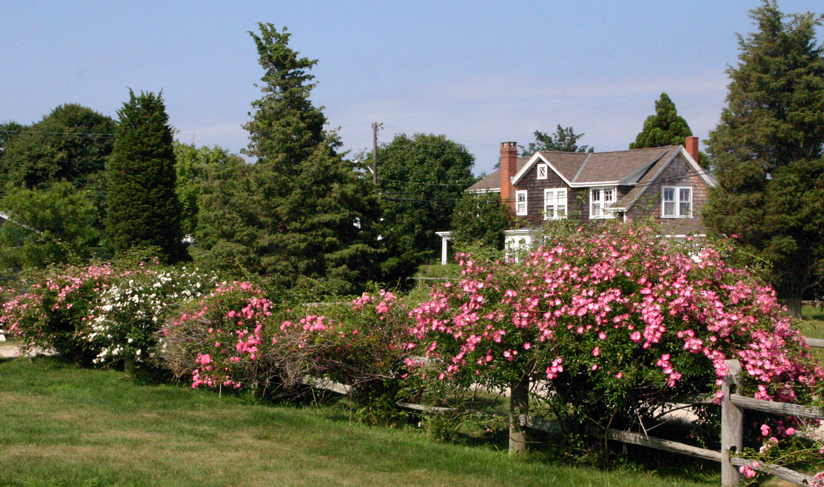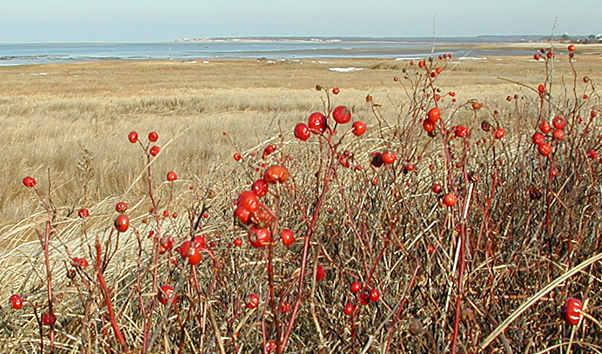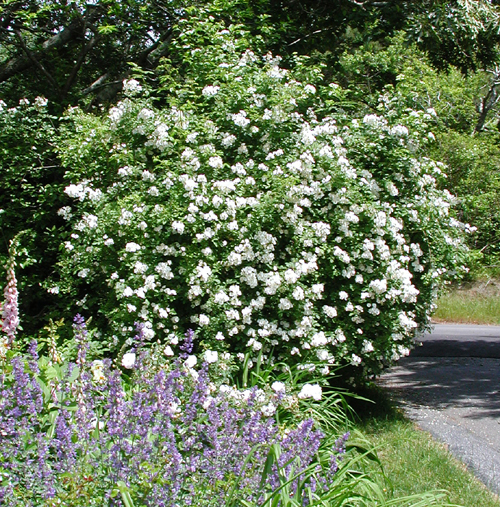| Cape Cod Heritage Roses | ||

| ||
| Cape Cod Heritage Roses | ||

| ||
Roses cover Cape Cod. From the high bluffs of Truro to the salt marshes of Sandwich, roses grow wild. These are the species roses; the ones that come true from seed. These wild roses fill several distinct ecological niches. The natives, Rosa virginiana and Rosa carolina, live in the damp and fertile areas; the salt marshes on the northern side of the Cape and the many freshwater kettle hole ponds up and down the interior. R. virginiana can even grow in the sand just above the high tide line as in this picture. Its shiny green leaves, red bristled stems and two inch deep pink flowers make it one of the most outstanding of the native roses. It is decorative year round with fine fall foliage and deep red hips in profusion. |
 |

|
Not all roses that inhabit Cape Cod are native to the area. Rosa Rugosa is native to Korea, Japan, and China. Rosa rugosa was first described by Swedish naturalist, Carl Peter Thunberg, in 1784 and introduced to Europe by him 50 years later. It was brought to New England in the late 19th century. It's native habitat is sand dunes and shores near the coast with low elevations. During the last century it has become naturalized on Cape Cod and most of the New England sea shore. |
Wherever you find the wild and tangled places is where Rosa multiflora thrives. Given the right conditions, it can scramble 30 feet up into a tree or make an impenetrable shrub 6 feet high by 6 feet across. It rarely grows by itself, but is more commonly a part of a tangled mass of honeysuckle, privet, poison ivy, and other rowdy plants that grab any convenient location that man neglects for more than a season. Not only do the flowers of multiflora come in huge sprays of small white or pink blooms, but the fragrance released into the air perfumes the neighborhood. This is the rose famous for the roles it played as the ancestor of many cultivated roses, such as Multiflora Ramblers, Polyanthas, and Floribundas. | 
|

|
It is the cultivated roses, though, with which we are most familiar. Roses have been cultivated by man for thousands of years and some of those grown by ancient man can be grown by us today. Most of the antique roses on the Cape are only a hundred years or so old. Cape Cod has many rose relics in some of the more preserved neighborhoods. Most commonly, one sees the rambling roses, climbing the sides of houses, engulfing fences, climbing through tangled masses of vegetation on property lines or spilling over stone walls. Along the old railroad lines in Hyannis one can find the most pragmatic uses I have seen for these ancient ramblers where they were used to hold the embankments from erosion. |
Michael Walsh |
The Walsh Catalog |
Rose Links |
Bibliography |
Copyright © 2018 Vernon H. Brown